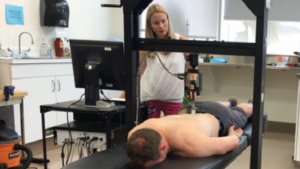Is back stiffness all in the mind?
New scientific evidence from a University of South Australia researcher shows ”“ for the first time ”“ that feelings of back stiffness may purely be a protective mechanism to avoid further injury.
A paper published today in Nature journal Scientific Reports by Dr Tasha Stanton, Senior Research Fellow in UniSA’s School of Health Sciences, provides evidence that the perception of back stiffness has no bearing on the actual state of the joints and that feelings of stiffness can be eased by certain sounds.
The clinical pain neuroscience researcher undertook a series of experiments, building on experiences of amputees who still report stiffness in joints which they no longer have.
Fifteen people with chronic lower back pain who reported feelings of back stiffness had pressure applied to the spine, paired with different sounds. Another control group of 15 healthy individuals with no back issues were also tested.
“We know that millions of people around the world have chronic lower back conditions but the feeling of stiffness may not actually reflect how bad their back is,” Dr Stanton said.
“In theory, people who feel back stiffness should have a stiffer spine than those who do not. We found this was not the case in reality. Instead, we found that that the amount they protected their back was a better predictor of how stiff their back felt.
“People with chronic back pain and stiffness overestimated how much force was being applied to their backs ”“ they were more protective of their back. How much they overestimated this force related to how stiff their backs felt ”“ the stiffer the back felt, the more they overestimated force. This suggests that feelings of stiffness are a protective response, likely to avoid movement.
“Secondly, we found that these feelings could be modulated using different sounds. The feeling of stiffness was worse with creaky door sounds and less with gentle whooshing sounds. This raises the possibility that we can clinically target stiffness without focusing on the joint itself but using other senses,” she said.
The breakthrough provides hope for the 632 million people worldwide who suffer from low back pain (approximately 10 per cent of the global population) and cannot find any relief.
“The brain uses information from numerous different sources including sound, touch, and vision, to create feelings such as stiffness,” Dr Stanton said. “If we can manipulate those sources of information, we then potentially have the ability to manipulate feelings of stiffness. This opens the door for new treatment possibilities which is incredibly exciting”.
Short URL: https://indiandownunder.com.au/?p=9545

